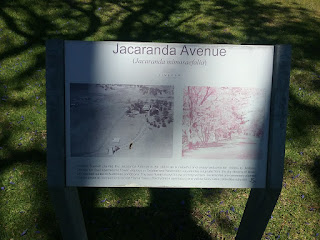Goomeri is half way between Hervey Bay and Dalby. 173 klms to be a little more precise. John's parents lived in Pratton Street and the kids grew up in the Dalby area.
Dale Herron served in World War 2, and was Mentioned in Dispatches for his bravery in operations in Laburnum Island in Borneo. After the War, there was a scheme to assist young men in gaining employment. Dale chose to learn Upholstery. He set up a shop in Dalby, sewing covers for prams and the like. He later sewed "sugar bags". Their eldest daughter was born in Dalby.
But holidays were spent at Hervey Bay, Grandma Schossow lived at Urangan, as did her sisters.
Due to ill health Dale later moved and opened an Upholstery shop in Main Street Hervey Bay, near the train station at Pialba.
Following the highway from Goomeri, the next major town was Kingaroy. The area was settled by early Scottish settlers, who developed farms, and raised cattle. Later, peanuts were grown very successfully. Today however there was a huge fire at the Barker Creek Piggery. It is a major source of employment in the area, and Barker Creek pork is well known. Wineries now thrive with many small cell-a-door vineyards operating.
Along the highway we passed the town of Bell. Then followed the MacAllister - Bell Road to Jimbour Station. What an interesting place!
Dennis parked the van under the shade of a Bottle Tree. This amazing tree soaks up moisture, and stores it until required. They are slow growing trees.
 |
Mary in the kitchen, where we had proper "corn beef" sandwiches. Now, corn beef sandwiches are not slices of meat with 500 grams of corn on top, but it is a term for a particular cut of beef, which is slow boiled, and an Australian favourite.
Early settlers also enjoyed their "corned beef" sandwiches - nothing much has changed. But now we are travelling in sheep country. Sheep means flies. Hundreds of them, and sometimes the only way to stop them settling on your face is to wear a hat with "corks" or a mesh netting.
Imagine for a moment the original settlers, landing in this strange country, the only clothes suited to the cold climates of UK, Scotland, Wales, Ireland and Germany. Certainly not suited to the hot conditions the outback offers.
Jimbour Station was first established in 1841 when an Englishman Henry Dennis, took up the Jimbour run for Scottish settler, Richard Scourgall who arrived from Scotland in 1832. It was stocked with 11,000 sheep and 700 catlle, and was the first fully stocked station on the Darling Downs.
In the beginning the property covered 300,000 acres of land.
In 1844, Ludwig Leichhardt, an explorer began a trip to discover the inland, trecking from Jimbour to the Northern Territory. In 1844, an Irishman Thomas Bell purchased the lot for 3,200 pounds.
Next owner was the Russell family, who still run the property today.
 |
| The Russell graves - they were in Parliament |
 |
| Avenue of Jacarandas planted in 1920's, and these flower in November |
 |
| Water Tower |
 |
| Chapel |
Jimbour House was first built in 1870's burnt down and rebuilt.
The magnificent trees surround the home
The next few photos give a bit of an idea of sheep farming. Thomas Jillett's sons drove 12500 sheep regularly from Roma in Queensland to Broadmeadows in Victoria, along the Inland trail. The sheep needed feed,and in this country drought is common. Once in Victoria, they would turn around and bring the sheep back to Roma. Some really interesting family experiences to be told about his sons. One son, Henric, had a relationship along the way, and the result is all the Jillett family in Glen Innis and the Northern areas of New South Wales
One of the sons, also married Mary's great aunt!! Small worlds.
































No comments:
Post a Comment